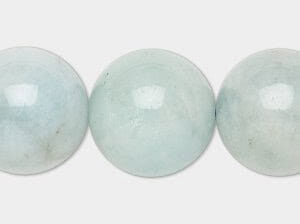Beryl Meaning and Properties
Beryl History
Beryl isn't so much a gemstone as it is a family of gemstones. Clear or colorless beryl is also called goshenite, while far more familiar versions are deep green beryl (emerald), teal to blue (aquamarine), rose to pink (morganite) and the dichroic (or "two-colored") alexandrite. Less common are the yellow-green to golden (heliodor or chrysoberyl), deep red (bixbite) and the extremely rare maxixe (pronounced mash-eesh), which starts as a bright blue and fades quickly in sunlight.
When gemstone-quality beryl appears—but doesn't fit these definitions—it is designated as precious beryl. Bead strands or gemological samples which contain a blend of different types of this gem family (goshenite with aquamarine is the most common) are often labeled "multi-beryl."
What are the Metaphysical Properties of Beryl?
Precious beryl is said to be first recognized as a powerful stone in ancient Mesopotamia, where beryl meaning involved strengthening belief in the gods. It was viewed as a healing stone in ancient Greece, where precious beryl was dipped into drinking water and that water was consumed to remove kidney stones and bladder ailments. Some oral traditions state that beryls of all kinds make the lazy more industrious and the slow-minded more clever. Precious beryl meaning is also associated with helping locate lost property and with divination.
While specific beryl varieties have their own properties (check their individual Gemstone Meanings articles for details), precious beryl tends to be affiliated by its color: blue-greens to the throat chakra, colorless to the crown chakra, golden-yellow heliodor to the solar plexus chakra, etc.
What is Beryl Made From?
Precious beryl is typically a lightly colored gemstone material, although increased color saturation also increases its value. It is mostly found in granite pegmatites, although some have been discovered in metamorphosed mica schists and in igneous rhyolite deposits. Unlike some of its more famous family members like the emerald, precious beryl of equal quality has fewer flaws, making the stone more sturdy . Precious beryl is transparent and has a vitreous luster.
In rare cases, precious beryl gemstones can display chatoyancy (cat’s eye effect) or asterism (exhibiting a star-like effect). These materials are most frequently cut into cabochons to enhance the effect.
Precious beryl can be found in Brazil, Madagascar, Zimbabwe, Myanmar (Burma), Sri Lanka and other places where other beryls commonly form—including rare, scattered finds in the northeastern United States.
- Mineral Information: Beryllium aluminum silicate, occasionally with some sodium, lithium and cesium
- Chemical Composition: Be3Al2Si6O18
- Color: Pale brownish-green, bluish-green and gray
- Hardness: 7-1/2 to 8 (Mohs)
- Specific Gravity: 2.63 – 2.92
- Refractive Index: 1.57 – 1.58
How Do You Clean Beryl?
Although precious beryl is a hard 7-1/2 to 8 on the Moh's scale, natural inclusions could make it vulnerable to breaking if exposed to extreme temperature changes or sharp blows. The best way to clean precious beryl jewelry is with warm water and a soft brush. Pat it dry with a soft cloth. Protect precious beryl from scratching and sharp blows that can fracture or shatter the stone. Avoid large temperature changes, ultrasonic cleaners and steam cleaners. Prolonged exposure to sunlight could fade any colors.
Beryl FAQ
Q: How did beryl get its name?
A: The name “beryl” is from the Greek word βηρυλλος (beryllos), which means precious blue-green stones.
Q: Why are there so many different colors of beryl?
A: Inclusion of different elements—for instance, manganese in morganite and chromium or vanadium in emerald—results in the wide variety of colors of beryl.
Q: How does beryl's crystal structure affect its clarity and brilliance?
A: Beryl has a hexagonal crystal structure, but it is the presence of inclusions that most affects clarity. Inclusion-free stones will offer much greater clarity than those with impurities in their structure. Because of that hexagonal structure, beryl can be precisely faceted for maximum brilliance.
Q: Are inclusions common in beryl?
A: Inclusions are common in some varieties of beryl, such as emerald, but relatively rare in others, such as aquamarine.
Q: Can beryl crystals grow to massive sizes?
A: Beryl crystals up to several meters in size can exist!
Designing with Beryl
The gentle pastels of precious beryl make it an ideal stone for feminine designs. Pair with color-compatible materials such as rose quartz and peach cultured freshwater pearls— or work with more intense colors in the same hues by pairing blue-green precious beryl with dumortierite, sodalite or amazonite.
Shop for Beryl
**Please note that all metaphysical or healing properties listed are collected from various sources. This information is offered as a service and not meant to treat medical conditions. Fire Mountain Gems and Beads® does not guarantee the validity of any of these statements.
How did you like this resource? Your feedback helps us provide resources that matter to you most.
Copyright Permissions
All works of authorship (articles, videos, tutorials and other creative works) are from the Fire Mountain Gems and Beads® Collection, and permission to copy is granted for non-commercial educational purposes only. All other reproduction requires written permission. For more information, please email copyrightpermission@firemtn.com.

